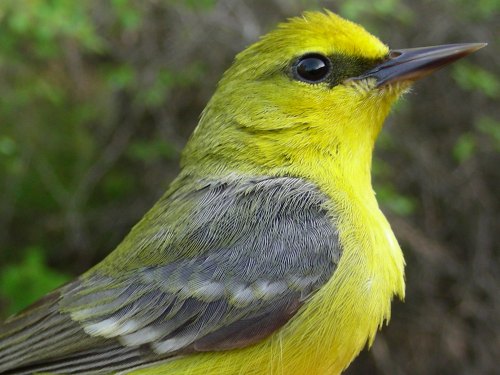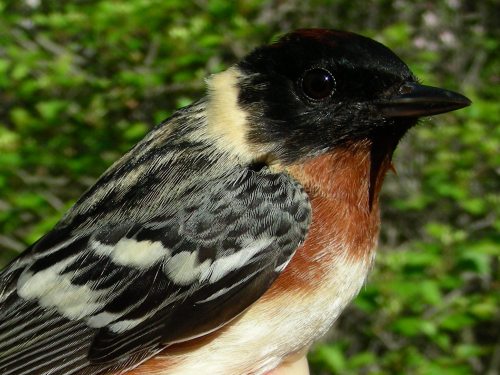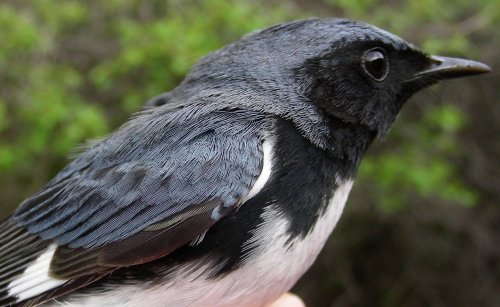|
McGILL BIRD OBSERVATORY |
|||||||||||||||||||||||||||||||||||||||||||||||||||||||||||||||||||||
Welcome
to the McGill Bird Observatory weekly report.
Click here for a complete listing of our archives.
Banders-in-charge: Simon Duval, Gay Gruner, Marie-Anne Hudson Notes: A quick non-birdy note as we begin this week’s banding log: we’re so proud and happy to announce that we’ve now got another BIC in the ranks! Simon Duval, our first official intern from last spring, has returned to us a fully permitted bander. Gay Gruner was also awarded a sub-permit earlier this year and has taken to MBO BIC-ing like a duck takes to water. We’re so thrilled to have two such dynamic and conscientious folks join us. Back to the birds: it’s startiiiiiiiing … daily species totals finally ranged from 45-61 this week, reflecting increasing diversity as the migrants began flooding in. We again beat last year’s total of 91 species observed in a week, and have a 10- and 12-species advantage over last season and year, respectively. We still trail last year in terms of the number of individuals banded by a considerable margin, but we’re bang on in terms of the number of species. This isn’t necessarily due to anything nefarious – it might simply be that 1) the bulk of migration is delayed, or 2) weather patterns are causing the birds to zip right over us without stopping for a rest, something we like to call the slingshot effect. This tends to be much more noticeable in spring than fall, since most species are in much more of a hurry to reach their breeding grounds. New species observed this week include (chronologically): Ruby-throated Hummingbird, Least Flycatcher, Ovenbird (Saturday), Cape May Warbler, Pine Warbler (Monday), American Kestrel, Magnolia Warbler (Tuesday), Bank Swallow, Scarlet Tanager, Red-breasted Nuthatch, Indigo Bunting (Wednesday), Purple Martin, Blue-winged Warbler (Thursday), and Tennessee Warbler, Blackburnian Warbler (Friday). New species banded for the season include: Yellow-rumped Warbler, Rose-breasted Grosbeak, Eastern White-crowned Sparrow, Baltimore Oriole, Chipping Sparrow, Eastern Kingbird, Gray Catbird, Common Yellowthroat, Black-throated Blue Warbler, Blue-winged Warbler, Yellow-bellied Sapsucker, Least Flycatcher, Magnolia Warbler and Bay-breasted Warbler. Despite the average number of Canada Geese seen per day dropping by roughly 200 birds, they remained at the top of this week’s top ten, followed closely by Cliff Swallow and Red-winged Blackbird. This may seem a little odd for anyone familiar with the site, but is actually a predictable occurrence at this time of year - both last year and in 2006, Cliff Swallow was the third most abundant species during week 7 of spring, and in 2007 they still cracked the list in 8th place. The explanation for this is that there is a Cliff Swallow colony under the nearby McGill weather station, and every year when they first return they swarm around the wider area for a bit before settling in - this time we saw around 100 from MBO on Friday alone. Ring-billed Gulls found their way back on the list, and an all-male group (that’s all we’ve caught so far) of Common Grackles have taken over the back pond (and our now successful J-trap), giving them sixth place. American Crow numbers dropped this week likely due to them settling into nesting territories, but the rest of the top ten table remained fairly stable, with the exception of Yellow Warbler, which snuck into tenth spot. We finally didn’t have to split the last spot in the banding table between several species this week, thanks to a small pick-up in the number of birds in the nets and to increasing diversity. The big birds have displaced the little ones, with Red-winged Blackbirds and Common Grackles taking the top spots. We have many new entries for the week: Common Grackle, Yellow Warbler, Baltimore Oriole, Nashville Warbler, Common Yellowthroat, Yellow-rumped Warbler, and Eastern White-crowned Sparrow. We’re predicting that more than four spots (this week’s total) will be filled by warblers in next week’s top ten!
|



